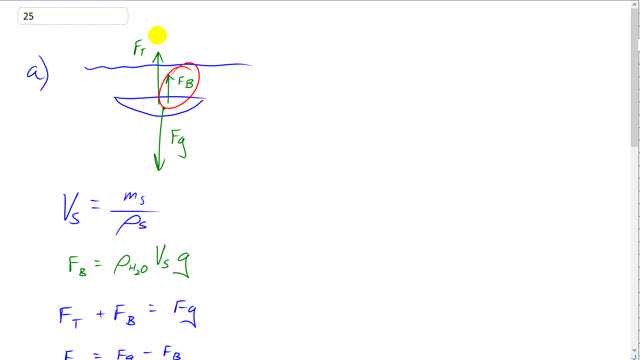
A crane lifts the 18,000-kg steel hull of a sunken ship out of the water. Determine
- the tension in the crane’s cable when the hull is fully submerged in the water, and
- the tension when the hull is completely out of the water.

In order to watch this solution you need to have a subscription.
This is Giancoli Answers with Mr. Dychko. When this ship is submerged, there's a buoyant force upwards as well as the tension force exerted by the crane and then there's gravity down but this buoyant force up due to the water reduces the amount of tension that's needed to compensate for this gravity downwards. So we have tension force up plus buoyant force up equals gravity down and in order to use these terms, we need to solve for some things first: we need to substitute for this buoyant force and the buoyant force will be equal to the weight of the water that's displaced by this ship. So we need to know what volume the ship is because you know, what volume of water is displaced then multiply that volume by the density of water to get its weight after multiplying by g of course. So volume of the ship will be the mass of the ship which we are given divided by the density of the ship which we are told is made out of steel so we'll put in density of steel there. So buoyant force is mass of the ship— density times volume— times g and we are gonna substitute this in there in a moment but I think I do that further down here. So here's Newton's second law and we can subtract the buoyant force from both sides to solve for the tension force and now we are substituting for each of these things: F g is mass of the ship times g and then buoyant force is density of water times the volume of the ship times g and then the volume of the ship at this point I substituted in m S, mass of the ship divided by density of the ship which is steel, and factor out the g here on this line and turns out we can also factor out the mass of the ship here so we have mass of the ship times g times 1 minus density of water divided by density of steel. So the tension force then is 18000 kilograms times 9.8 newtons per kilogram times 1 minus density of water—1.00 times 10 to the 3 kilograms per cubic meter— divided by 7.8 times 10 to the 3 kilograms per cubic meter which is 1.5 times 10 to the 5 newtons will be the tension force. Now for the tension when, the ship is out of the water, I wrote this but technically, it should be this multiplied by 1 minus density of air divided by density of the ship because there's still a fluid being displaced but the fluid is now air; the word 'fluid' doesn't just mean liquids, it also means gases. So there's this density of air divided by density of the ship term too but we don't bother writing it because the density of air is only 1.29 kilograms per cubic meter or something like that and we take that and divide it by 7800 kilograms per cubic meter— density of steel— that is a negligible term so 1 minus this tiny number is still gonna be 1 basically so that's why you don't see it there but just so you know what we are doing here; we are making an approximation. And so 1.8 times 10 to the 5 newtons will be the tension force after you multiply the mass of the ship by gravitational field strength.
how did u get the number 7.8 x 10^3
I was wondering that too. its the density of steel, it comes up on google when you search it up